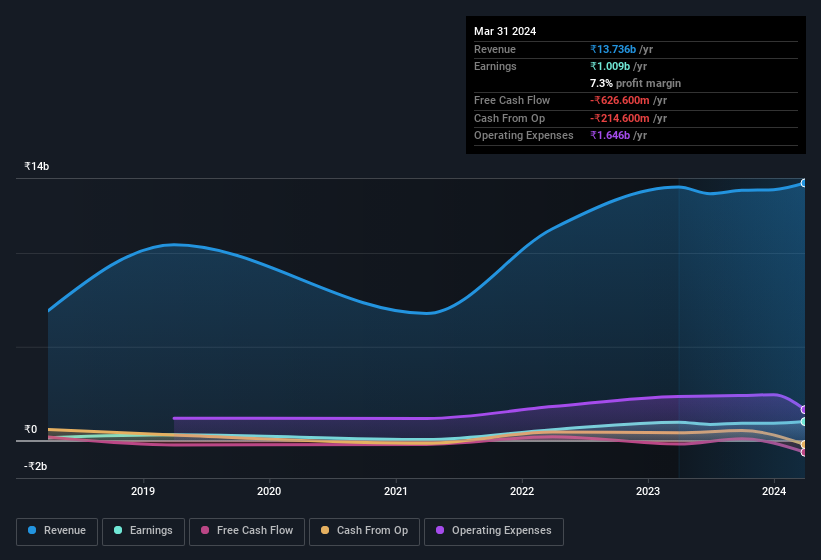- India
- /
- Specialty Stores
- /
- NSEI:KALAMANDIR
Sai Silks (Kalamandir)'s (NSE:KALAMANDIR) Earnings Are Of Questionable Quality

Investors were disappointed with Sai Silks (Kalamandir) Limited's (NSE:KALAMANDIR) earnings, despite the strong profit numbers. We did some digging and found some worrying underlying problems.
View our latest analysis for Sai Silks (Kalamandir)

Examining Cashflow Against Sai Silks (Kalamandir)'s Earnings
As finance nerds would already know, the accrual ratio from cashflow is a key measure for assessing how well a company's free cash flow (FCF) matches its profit. The accrual ratio subtracts the FCF from the profit for a given period, and divides the result by the average operating assets of the company over that time. This ratio tells us how much of a company's profit is not backed by free cashflow.
Therefore, it's actually considered a good thing when a company has a negative accrual ratio, but a bad thing if its accrual ratio is positive. While having an accrual ratio above zero is of little concern, we do think it's worth noting when a company has a relatively high accrual ratio. That's because some academic studies have suggested that high accruals ratios tend to lead to lower profit or less profit growth.
For the year to March 2024, Sai Silks (Kalamandir) had an accrual ratio of 0.20. We can therefore deduce that its free cash flow fell well short of covering its statutory profit. Even though it reported a profit of ₹1.01b, a look at free cash flow indicates it actually burnt through ₹627m in the last year. We also note that Sai Silks (Kalamandir)'s free cash flow was actually negative last year as well, so we could understand if shareholders were bothered by its outflow of ₹627m.
That might leave you wondering what analysts are forecasting in terms of future profitability. Luckily, you can click here to see an interactive graph depicting future profitability, based on their estimates.
Our Take On Sai Silks (Kalamandir)'s Profit Performance
Sai Silks (Kalamandir)'s accrual ratio for the last twelve months signifies cash conversion is less than ideal, which is a negative when it comes to our view of its earnings. Because of this, we think that it may be that Sai Silks (Kalamandir)'s statutory profits are better than its underlying earnings power. But on the bright side, its earnings per share have grown at an extremely impressive rate over the last three years. Of course, we've only just scratched the surface when it comes to analysing its earnings; one could also consider margins, forecast growth, and return on investment, among other factors. In light of this, if you'd like to do more analysis on the company, it's vital to be informed of the risks involved. For example, we've found that Sai Silks (Kalamandir) has 2 warning signs (1 is significant!) that deserve your attention before going any further with your analysis.
This note has only looked at a single factor that sheds light on the nature of Sai Silks (Kalamandir)'s profit. But there is always more to discover if you are capable of focussing your mind on minutiae. Some people consider a high return on equity to be a good sign of a quality business. So you may wish to see this free collection of companies boasting high return on equity, or this list of stocks with high insider ownership.
New: Manage All Your Stock Portfolios in One Place
We've created the ultimate portfolio companion for stock investors, and it's free.
• Connect an unlimited number of Portfolios and see your total in one currency
• Be alerted to new Warning Signs or Risks via email or mobile
• Track the Fair Value of your stocks
Have feedback on this article? Concerned about the content? Get in touch with us directly. Alternatively, email editorial-team (at) simplywallst.com.
This article by Simply Wall St is general in nature. We provide commentary based on historical data and analyst forecasts only using an unbiased methodology and our articles are not intended to be financial advice. It does not constitute a recommendation to buy or sell any stock, and does not take account of your objectives, or your financial situation. We aim to bring you long-term focused analysis driven by fundamental data. Note that our analysis may not factor in the latest price-sensitive company announcements or qualitative material. Simply Wall St has no position in any stocks mentioned.
About NSEI:KALAMANDIR
Excellent balance sheet with acceptable track record.
Similar Companies
Market Insights
Community Narratives




